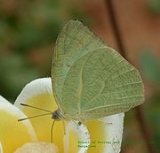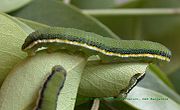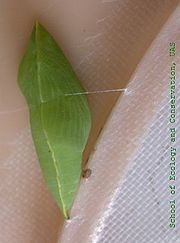
Catopsilia pyranthe
Encyclopedia
The Mottled Emigrant, Catopsilia pyranthe, is a medium sized butterfly
of the Family Pieridae
found in South Asia
, Southeast Asia
and parts of Australia
.
-_male_in_hyderabad,_ap_w_img_7139.jpg) The upperside is chalky-white, slightly tinted in some specimens with green. The fore wing is with or without a discocellular black spot, that varies in size; costa and termen sometimes without a black margin; occasionally the costa has its apical third narrowly black, broadened slightly at the apex with black spots between the anterior veins; or again, the costa may be narrowly black, the apex very broadly so, and this colour continued down the termen but narrowed posteriorly. The hind wing is sometimes immaculate, but generally with narrow terminal black spots at the apices of the veins, these often reduced to mere dots, or again so broadened as to coalesce into a narrow terminal black margin.
The upperside is chalky-white, slightly tinted in some specimens with green. The fore wing is with or without a discocellular black spot, that varies in size; costa and termen sometimes without a black margin; occasionally the costa has its apical third narrowly black, broadened slightly at the apex with black spots between the anterior veins; or again, the costa may be narrowly black, the apex very broadly so, and this colour continued down the termen but narrowed posteriorly. The hind wing is sometimes immaculate, but generally with narrow terminal black spots at the apices of the veins, these often reduced to mere dots, or again so broadened as to coalesce into a narrow terminal black margin.
The underside's ground-color is similar, suffused on the anterior half of the fore and over the whole surface of the hind wing with a greenish tint that varies to an ochraceous yellow, and, except in the very palest specimens, is evenly irrorated over the greenish or ochraceous-tinted areas with transverse, short, reddish-brown strigae; both fore and hind wings with generally an obscure discocellular reddish-brown spot or indication thereof.
_mating_in_hyderabad,_ap_w_img_9444.jpg)
 The upperside is as in the male, but sometimes with a suffusion of pale greenish yellow on the terminal third or fourth only of both fore and hind wings, rarely of that tint throughout. The fore wing is always with a discocellular black spot that varies very much in size; costa sometimes narrowly black with the basal half pinkish, in other specimens narrowly black throughout, the black broadened at the apex and continued along the anterior half of the termen in a series of inwardly-pointed black spots; or again, the costa may be more broadly black, that colour widened considerably at the apex and continued broadly down the termen to vein 3, then suddenly narrowed to a slender line at the tornus. In most specimens there is an anterior postdiscal short black macular baud; in the dark forms this coalesce with the black on apex and termen. The hind wing is sometimes immaculate, sometimes with a series of terminal spots at the apices of the veins, sometimes with a narrow dusky-black terminal band broadest near the apex, narrowed posteriorly to a slender line at the tornus. In the very dark specimens there is in addition an ill-defined, short anterior postdiscal macular black band.
The upperside is as in the male, but sometimes with a suffusion of pale greenish yellow on the terminal third or fourth only of both fore and hind wings, rarely of that tint throughout. The fore wing is always with a discocellular black spot that varies very much in size; costa sometimes narrowly black with the basal half pinkish, in other specimens narrowly black throughout, the black broadened at the apex and continued along the anterior half of the termen in a series of inwardly-pointed black spots; or again, the costa may be more broadly black, that colour widened considerably at the apex and continued broadly down the termen to vein 3, then suddenly narrowed to a slender line at the tornus. In most specimens there is an anterior postdiscal short black macular baud; in the dark forms this coalesce with the black on apex and termen. The hind wing is sometimes immaculate, sometimes with a series of terminal spots at the apices of the veins, sometimes with a narrow dusky-black terminal band broadest near the apex, narrowed posteriorly to a slender line at the tornus. In the very dark specimens there is in addition an ill-defined, short anterior postdiscal macular black band.
The underside is as in the male, with similar variations, but in addition in most specimens the discocellular spots are well-defined with an outer red ring that encircles a silvery spot; on the hind wing one or two similar spots on each side of the discocellulars; generally also both wings are crossed by a transverse postdiscal line of minute red spots, which on the fore wing is confined to the anterior portion, on the hind wing is nearly complete. In both sexes: antennae reddish, head and thorax anteriorly brown, thorax clothed posteriorly with long white hairs, abdomen white: beneath: the palpi, thorax and abdomen white.
 The host plants of the species include Cassia spp. (e.g. C. fistula
The host plants of the species include Cassia spp. (e.g. C. fistula
; C. javanica or C. roxburghii; C. bakeriana), Gnidia glauca, Senna
spp. (e.g. S. alata
; S. auriculata
; S. garrettiana), Crotalaria
spp., Ormocarpum cochinchinense, Sesbania
spp. and Colocasia
.
 The development period from egg to adult is 22 to 29 days allowing up to 11-12 generations a year.
The development period from egg to adult is 22 to 29 days allowing up to 11-12 generations a year.
Larva: "Long, somewhat depressed, rough, green, with a white lateral line and above it a black line more or less conspicuous, formed by minute black shining tubercles. In short, this larva in very like a big specimen of a Eurema hecabe
"
Pupa: "Much stouter (i.e. than that of Eurema hecabe
, and the keel formed by the wing-cases much less pronounced. The normal colour is pale green with a yellow lateral line. We have never found it on any plant except Senna occidentalis
. It habitually rests on the upperside along the midrib, like almost all Pierine larvae." Davidson and Aitken
, quoted in Bingham.
Butterfly
A butterfly is a mainly day-flying insect of the order Lepidoptera, which includes the butterflies and moths. Like other holometabolous insects, the butterfly's life cycle consists of four parts: egg, larva, pupa and adult. Most species are diurnal. Butterflies have large, often brightly coloured...
of the Family Pieridae
Pieridae
The Pieridae are a large family of butterflies with about 76 genera containing approximately 1,100 species, mostly from tropical Africa and Asia. Most pierid butterflies are white, yellow or orange in coloration, often with black spots...
found in South Asia
South Asia
South Asia, also known as Southern Asia, is the southern region of the Asian continent, which comprises the sub-Himalayan countries and, for some authorities , also includes the adjoining countries to the west and the east...
, Southeast Asia
Southeast Asia
Southeast Asia, South-East Asia, South East Asia or Southeastern Asia is a subregion of Asia, consisting of the countries that are geographically south of China, east of India, west of New Guinea and north of Australia. The region lies on the intersection of geological plates, with heavy seismic...
and parts of Australia
Australia
Australia , officially the Commonwealth of Australia, is a country in the Southern Hemisphere comprising the mainland of the Australian continent, the island of Tasmania, and numerous smaller islands in the Indian and Pacific Oceans. It is the world's sixth-largest country by total area...
.
Male
-_male_in_hyderabad,_ap_w_img_7139.jpg)
The underside's ground-color is similar, suffused on the anterior half of the fore and over the whole surface of the hind wing with a greenish tint that varies to an ochraceous yellow, and, except in the very palest specimens, is evenly irrorated over the greenish or ochraceous-tinted areas with transverse, short, reddish-brown strigae; both fore and hind wings with generally an obscure discocellular reddish-brown spot or indication thereof.
_mating_in_hyderabad,_ap_w_img_9444.jpg)
Female

The underside is as in the male, with similar variations, but in addition in most specimens the discocellular spots are well-defined with an outer red ring that encircles a silvery spot; on the hind wing one or two similar spots on each side of the discocellulars; generally also both wings are crossed by a transverse postdiscal line of minute red spots, which on the fore wing is confined to the anterior portion, on the hind wing is nearly complete. In both sexes: antennae reddish, head and thorax anteriorly brown, thorax clothed posteriorly with long white hairs, abdomen white: beneath: the palpi, thorax and abdomen white.
Life history

Golden Shower Tree
Cassia fistula, known as the golden shower tree and other names, is a flowering plant in the family Fabaceae, native to southern Asia, from southern Pakistan east through India to Myanmar and south to Sri Lanka. It is the national tree of Thailand, and its flower is Thailand's national flower...
; C. javanica or C. roxburghii; C. bakeriana), Gnidia glauca, Senna
Senna (genus)
Senna , the sennas, is a large genus of flowering plants in the family Fabaceae, subfamily Caesalpinioideae. This diverse genus is native throughout the tropics, with a small number of species reaching into temperate regions. The number of species is usually estimated to be about 260, but some...
spp. (e.g. S. alata
Senna alata
Senna alata, the Candle Bush, is an important medicinal tree as well as an ornamental flowering plants in the subfamily Caesalpinioideae. It also known as a Candelabra Bush, Empress Candle Plant, Ringworm Tree or "candletree"...
; S. auriculata
Senna auriculata
Senna auriculata is a legume tree in the subfamily Caesalpinioideae. It is commonly known by its local names ranawara or avaram, Senna auriculata is a legume tree in the subfamily Caesalpinioideae. It is commonly known by its local names ranawara or avaram, Senna auriculata is a legume tree in the...
; S. garrettiana), Crotalaria
Crotalaria
Crotalaria is a genus of herbaceous plants and woody shrubs in the Family Fabaceae commonly known as rattlepods. Some 600 or more species of Crotalaria are described worldwide, mostly from the tropics; at least 500 species are known from Africa. Some species of Crotalaria are grown as ornamentals...
spp., Ormocarpum cochinchinense, Sesbania
Sesbania
Sesbania is a genus of flowering plants in the pea family, Fabaceae and the only genus found in Tribe Sesbanieae. Notable species include the Rattlebox , Spiny Sesbania , and Sesbania sesban, which is used in cooking...
spp. and Colocasia
Colocasia
Colocasia is a genus of 25 or more species of flowering plants in the family Araceae, native to tropical Polynesia and southeastern Asia. Common names include Elephant-ear, Taro, Cocoyam, Dasheen,Chembu, and Eddoe...
.

Larva: "Long, somewhat depressed, rough, green, with a white lateral line and above it a black line more or less conspicuous, formed by minute black shining tubercles. In short, this larva in very like a big specimen of a Eurema hecabe
Eurema hecabe
The Large Grass Yellow or Common Grass Yellow is a small pierid butterfly species found in Asia or Africa. They are found flying close to the ground and are found in open grass and scrub habitats...
"
Pupa: "Much stouter (i.e. than that of Eurema hecabe
Eurema hecabe
The Large Grass Yellow or Common Grass Yellow is a small pierid butterfly species found in Asia or Africa. They are found flying close to the ground and are found in open grass and scrub habitats...
, and the keel formed by the wing-cases much less pronounced. The normal colour is pale green with a yellow lateral line. We have never found it on any plant except Senna occidentalis
Senna occidentalis
Senna occidentalis is a pantropical plant species.Vernacular names include : ʻauʻaukoʻi in Hawaii, coffee senna, coffeeweed, Mogdad coffee, negro-coffee, senna coffee, Stephanie coffee, stinkingweed or styptic weed....
. It habitually rests on the upperside along the midrib, like almost all Pierine larvae." Davidson and Aitken
Edward Hamilton Aitken
Edward Hamilton Aitken was a civil servant in India, better known for his humorist writings on natural history in India and as a founding member of the Bombay Natural History Society...
, quoted in Bingham.

